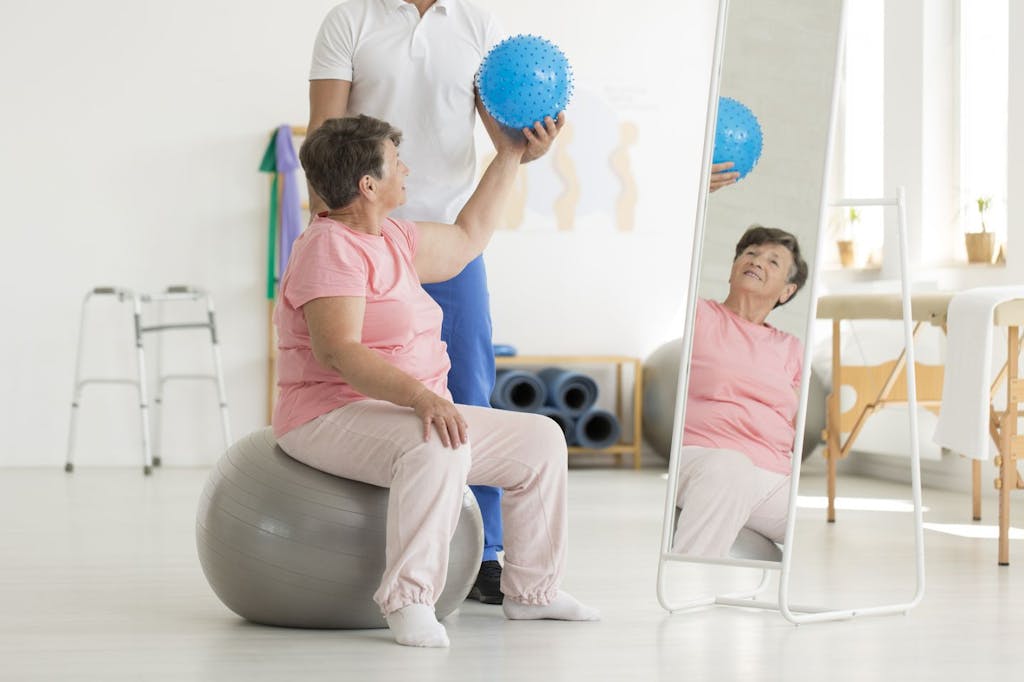Dizziness is a common problem that many people experience at some point in their lives. It can be caused by a variety of factors, such as inner ear problems, medications, or health conditions. If you are experiencing dizziness, it is important to seek medical help right away. However, there are some exercises that you can do at home to help improve your symptoms. In this blog post, we will discuss the 5 best physical therapy exercises for dizziness.
Contents
- 1 Understanding Dizziness
- 2 Does physical therapy work for dizziness?
- 3 The Best Physical Therapy Exercises For Dizziness
- 4 How It Is Beneficial?
- 4.1 Improve your balance and coordination
- 4.2 Strengthen your muscles
- 4.3 Reduce stress and anxiety
- 4.4 Improve your overall fitness
- 4.5 Identify the root cause of your dizziness
- 4.6 Non-invasive and no side effects
- 4.7 Treat a variety of causes of dizziness
- 4.8 Relieve your symptoms
- 4.9 Effective treatment
- 5 Conclusion
Understanding Dizziness

Dizziness is a feeling of lightheadedness, unsteadiness, or spinning. Dizziness can be caused by many things, including inner ear problems, low blood pressure, anemia, dehydration, low blood sugar, and certain medications. Dizziness can also be a symptom of more serious problems such as stroke or a heart attack.
Does physical therapy work for dizziness?
Yes, physical therapy can be an effective treatment for dizziness. A physical therapist can help you identify the underlying cause of your dizziness and develop a customized treatment plan to address it.
There are several different exercises that can help treat dizziness.
The Best Physical Therapy Exercises For Dizziness
There are various physical therapy Exercises for dizziness. They are as follows:
The Epley maneuver
This exercise is often used to treat benign paroxysmal positional vertigo (BPPV), a common cause of dizziness. The Epley maneuver involves moving your head into certain positions and then holding it there for a short period. For example, you may lie on your back and then tilt your head to the side. Your therapist will then move your head up and down and from side to side.
Balance training
This helps in improving balance and coordination. It is often done by practicing standing on one leg or walking heel to toe. For instance, the Epley maneuver is a balance training exercise that can help reduce the symptoms of dizziness.
It can help reduce dizziness. For example, stand on one leg or walk heel to toe in a straight line. For example, stand on one leg or walk heel to toe in a straight line.
Vestibular rehabilitation
This therapy makes use of specific exercises and activities to help retrain the vestibular system. This can help reduce dizziness and improve balance. For instance, the Epley maneuver is a type of vestibular rehabilitation that can be used to treat benign paroxysmal positional vertigo (BPPV). This condition is caused by loose particles in the inner ear, and the Epley maneuver can help to move these particles out of the inner ear.
Other vestibular rehabilitation exercises may include:
- Gaze stabilization exercises: These help to retrain the eyes and improve gaze stability. This help improves your ability to keep your eyes still, which can help reduce dizziness. For example, try looking at an object in the distance and then quickly looking back at something close to you.
- Habituation exercises: These involve repeatedly exposing yourself to situations that trigger dizziness to help reduce your overall sensitivity to them. For example, if you feel dizzy when looking up, down, or to the side, you may do exercises that involve repeatedly moving your head in these directions.
Gait training
This helps in improving the way you walk. It is often done by practicing walking with a cane or walker. For instance, if you have problems with your balance,
The therapist can help by prescribing a walking exercise regimen that includes using these devices.
Strength training
This helps in strengthening the muscles that support the spine and neck. This can help reduce pain and improve function. For instance, sit on a ball and roll forwards and backward or side to side. You can also try isometric exercises, where you push against something without moving.
Eye exercises
This help improves your eye movements and coordination, which can reduce dizziness. For example, try following an object with your eyes without moving your head. For example, try following an object with your eyes without moving your head.
Flexibility exercises
These help in stretching the muscles and improving the range of motion. This can help reduce pain and improve function. For example, the hamstrings can be stretched by lying on your back with one leg extended and the other bent. You then reach for your toes and hold the stretch for 30 seconds.
Stability exercises
This help improves balance and coordination. They also help in strengthening the muscles that support the spine. For example, standing on one leg while keeping your eyes
These are the best physical therapy Exercises for dizziness. Choose the one that suits you the most and start doing it regularly to get relief from dizziness. It Is important to consult with a physiotherapist first.
Even though these physical therapy exercises for dizziness are generally safe, it is always best to consult with a physiotherapist before starting any new exercise regime. This is because the physiotherapist can assess your condition and tailor an exercise program that is specifically suited for you.
Start Doing These Exercises Today: If you suffer from dizziness, don’t wait any longer, and start doing these exercises. They may just be what you need to finally get rid of that pesky dizziness once and for all!
How It Is Beneficial?

Physical therapy for dizziness is helpful as follows:
Improve your balance and coordination
You will likely do balance exercises during physical therapy for dizziness. These exercises can help improve your balance and coordination, which can help prevent falls. This is important because dizziness can often be caused by problems with these skills. By improving your balance and coordination, you can help reduce your risk of falling and injury.
Strengthen your muscles
Physical therapy for dizziness can also help strengthen the muscles that support your head and neck. This can help reduce the strain on your neck and reduce the risk of dizziness. For example, if you have neck pain, physical therapy can help strengthen the muscles in your neck to ease the pain and improve your range of motion.
Reduce stress and anxiety
Dizziness can often be caused by stress and anxiety. Physical therapy can help reduce these feelings by teaching you relaxation techniques. For example, you may learn deep breathing exercises or progressive muscle relaxation. These techniques can help you feel more relaxed and reduce your risk of dizziness.
The relaxation techniques that you may learn during physical therapy can also help reduce stress and anxiety. This can lead to less dizziness.
Improve your overall fitness
You can help reduce your risk of dizziness by improving your overall fitness. Start with some basic aerobic exercises, such as walking or riding a stationary bike for 10 to 15 minutes three times a week. As you get used to this routine, gradually increase the amount of time you exercise. Physical therapy for dizziness can help improve your quality of life. It can help you stay active and independent. It can also help you better manage your condition.
One way to prevent dizziness is to keep your neck muscles strong. Try these simple exercises:
- Tilt your head slowly back and forth, then side to side.
- Do shoulder shrugs—raise your shoulders toward your ears, then release.
Make sure you warm up before you do any of these exercises. And if they make your symptoms worse, stop doing them and see your doctor.
Identify the root cause of your dizziness
To properly treat dizziness, it is important to first identify the underlying cause. Dizziness can be caused by a variety of factors, including inner ear problems, medication side effects, or even anxiety or stress. A physical therapist can help you determine the root cause of
Non-invasive and no side effects
Physical therapy is a safe and effective treatment for dizziness. It is non-invasive and has no side effects. This makes it a great treatment option for people of all ages. For instance, if you are pregnant, physical therapy can help relieve your dizziness without posing any risks to your baby.
Treat a variety of causes of dizziness
Physical therapy can be used to treat a wide range of causes of dizziness. This includes vestibular problems, such as labyrinthitis or Benign Paroxysmal Positional Vertigo (BPPV). It can also help treat other conditions that can cause dizziness, such as migraines or anxiety. The best way to manage your dizziness is with a comprehensive treatment plan that includes physical therapy exercises. While there is no cure for dizziness, physical therapy can help lessen the symptoms and improve your quality of life.
Relieve your symptoms
Physical therapy can help relieve the symptoms of dizziness. This includes helping you to feel less lightheaded and nauseous. It can also help reduce the spinning sensation that is often associated with dizziness.
Effective treatment
Physical therapy is an effective treatment for dizziness. It is often the first line of treatment recommended by doctors. This is because it is safe, non-invasive, and has few side effects.
If you are experiencing dizziness, talk to your doctor about the possibility of physical therapy. It is a safe and effective treatment option that can help you find relief from your symptoms.
Conclusion
It may be concluded that physical therapy for dizziness, specifically the exercises mentioned above, can be highly effective in treating dizziness. These exercises can help to improve balance and coordination, as well as increase strength and flexibility. If you are suffering from dizziness, it is important to consult with a physical therapist to develop an individualized treatment plan.
Physical Therapy help patients recover from pain. If you’re experiencing Back pain, Shoulder pain, Knee pain, Neck pain, Elbow pain, Hip pain, or Arthritis pain, a physical therapist at MantraCare can help: Book a physiotherapy session.


